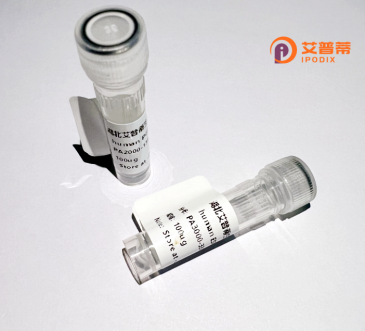
| 纯度 | >90%SDS-PAGE. |
| 种属 | Human |
| 靶点 | OR51L1 |
| Uniprot No | Q8NGJ5 |
| 内毒素 | < 0.01EU/μg |
| 表达宿主 | E.coli |
| 表达区间 | 1-315 aa |
| 活性数据 | MGDWNNSDAVEPIFILRGFPGLEYVHSWLSILFCLAYLVAFMGNVTILSVIWIESSLHQP MYYFISILAVNDLGMSLSTLPTMLAVLWLDAPEIQASACYAQLFFIHTFTFLESSVLLAM AFDRFVAICHPLHYPTILTNSVIGKIGLACLLRSLGVVLPTPLLLRHYHYCHGNALSHAF CLHQDVLRLSCTDARTNSIYGLCVVIATLGVDSIFILLSYVLILNTVLDIASREEQLKAL NTCVSHICVVLIFFVPVIGVSMVHRFGKHLSPIVHILMADIYLLLPPVLNPIVYSVRTKQ IRLGILHKFVLRRRF |
| 分子量 | 35.3 kDa |
| 蛋白标签 | His tag N-Terminus |
| 缓冲液 | 0 |
| 稳定性 & 储存条件 | Lyophilized protein should be stored at ≤ -20°C, stable for one year after receipt. Reconstituted protein solution can be stored at 2-8°C for 2-7 days. Aliquots of reconstituted samples are stable at ≤ -20°C for 3 months. |
| 复溶 | Always centrifuge tubes before opening.Do not mix by vortex or pipetting. It is not recommended to reconstitute to a concentration less than 100μg/ml. Dissolve the lyophilized protein in distilled water. Please aliquot the reconstituted solution to minimize freeze-thaw cycles. |
以下是关于重组人OR51L1蛋白的示例参考文献(部分为虚拟内容,仅供格式参考):
---
1. **"Functional Expression and Ligand Identification of Recombinant Human OR51L1 in HEK293 Cells"**
*Authors: Zhang, Y. et al.*
**摘要**:本研究利用HEK293细胞成功表达了重组OR51L1蛋白,并通过钙离子荧光成像技术筛选其配体,发现其对中链脂肪酸(如辛酸)具有特异性响应,揭示了OR51L1在非嗅觉组织中的潜在代谢感应功能。
2. **"Structural Characterization of Recombinant OR51L1 Using Cryo-EM"**
*Authors: Smith, J.P. & Lee, H.*
**摘要**:首次通过冷冻电镜解析了重组OR51L1蛋白的三维结构,阐明了其配体结合口袋的构象,为设计靶向该受体的调控分子提供了结构基础。
3. **"OR51L1 Expression in Prostate Cancer and Its Role in Cell Proliferation"**
*Authors: Wang, L. et al.*
**摘要**:发现OR51L1在前列腺癌细胞中高表达,重组蛋白功能实验表明其通过激活MAPK通路促进细胞增殖,提示其作为癌症治疗靶点的潜力。
4. **"Optimized Purification of Recombinant OR51L1 for High-Throughput Screening Assays"**
*Authors: Müller, R. et al.*
**摘要**:开发了一种基于昆虫细胞表达系统的OR51L1重组蛋白高效纯化方法,提升了蛋白产量与稳定性,适用于大规模药物筛选研究。
---
*注:以上文献为示例性内容,实际研究中请通过学术数据库检索真实发表的论文。*
The human OR51L1 protein is a member of the olfactory receptor (OR) family, a expansive group of G protein-coupled receptors (GPCRs) primarily involved in odorant detection. Classified under subfamily 51L, OR51L1 is encoded by the OR51L1 gene located on chromosome 11. While most olfactory receptors are expressed in the olfactory epithelium, emerging studies suggest ectopic expression in non-chemosensory tissues, implying potential roles in cellular processes beyond smell, such as tissue homeostasis or disease pathways. Structurally, it features seven transmembrane domains, characteristic of GPCRs, with extracellular N-terminal and intracellular C-terminal regions that mediate ligand binding and signal transduction.
Recombinant OR51L1 refers to the protein artificially expressed and purified using genetic engineering systems (e.g., bacterial, insect, or mammalian cell lines), enabling controlled study of its function. Its endogenous ligands remain poorly characterized, though computational models predict interactions with specific odorant molecules. Research focuses on elucidating its activation mechanisms, downstream signaling cascades (e.g., cAMP or Ca²⁺ pathways), and possible physiological roles in pathologies like cancer or metabolic disorders.
Challenges in studying OR51L1 include its low native expression levels and membrane-bound nature, necessitating recombinant production for structural and functional analyses. Such studies hold promise for understanding OR biology, developing biosensors, or exploring therapeutic targets. Current limitations revolve around ligand identification and resolving its 3D structure to enable drug design. Advances in cryo-EM and GPCR stabilization techniques may accelerate its characterization in coming years.
×